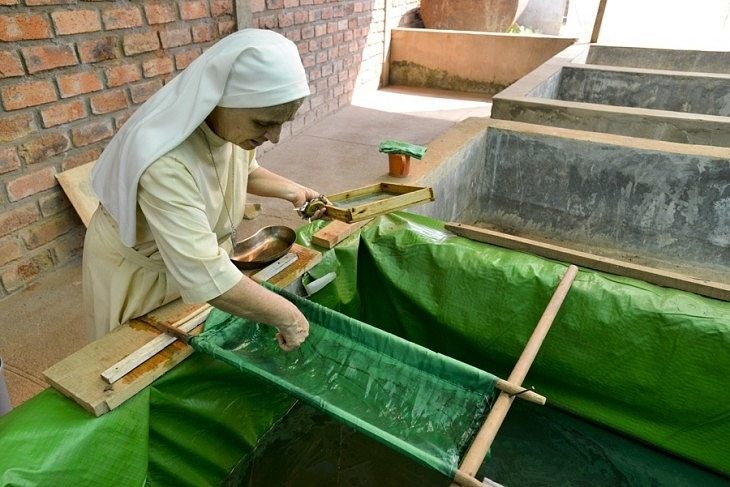Much of the work we do as gardeners involves pulling weeds, and many of us can attest that this is not our favorite part. The good news is that there are many common garden weeds you can leave right where they are.
Edible weeds have been a common food source throughout history and a regular part of the American diet up until the rise of the supermarket and the shift towards large-scale agriculture. More recently, people have been re-discovering these nutrient-rich plants as part of a healthy, organic diet, and, as a result, educational opportunities abound. There is a variety of books, websites, classes and entire schools dedicated to teaching how to harvest and prepare these foods. If you read up on the subject, you will also find many wild, edible weeds offer the added benefit of medicinal properties.
Getting Started
The best way to get started is to learn how to identify your garden weeds. There are some very useful book resources out there with colored guides to positively identify the plants you are looking for and “weed” out poisonous look-alikes. Petersen Field Guide: Edible Wild Plants, by Lee Allen Peterson is a handy all-around reference that includes more than 370 edible plants, colored illustrations, photographs, and directions on preparation. If you want to get a little more in-depth on some of the more common wild edibles, Edible Wild Plants: Wild Foods from Dirt to Plate by John Kallas, Ph.D. includes thorough identification and recipes. There are also many local wild food groups popping up in towns everywhere, and an internet search should turn up local organizations.
There are also many local wild food groups popping up in towns everywhere, and an Internet search should turn up local organizations, workshops, and plant walks. Social media sites like Facebook offer another resource for national and local plant identification groups. On-line communities are a great place to ask questions, post-plant pictures, and benefit from the collective knowledge of others. Once you feel comfortable with identification, you can go out and start shopping for free in your own backyard.
Dandelion
The first and most common of these weeds is the dandelion. This plant is tenacious, managing to grow everywhere from cracks in sidewalks to all over your lawn. There is a huge agrichemical industry geared towards the American homeowner and the idea that a well-kept lawn is a weed-free lawn, with the dandelion depicted as the number one enemy. People are convinced they should spend their time and money eradicating the dandelion with harmful herbicides. The truth is, dandelions are very useful and are easily managed by hand-pulling and regular harvesting. The greens that emerge in the early spring are rich in antioxidants, Beta-carotene, vitamin C, Vitamin D, iron, calcium, magnesium, zinc, phosphorous, sodium, and a variety of trace minerals. They are also fairly high in protein. Not only can you eat the leaves, but the cheery yellow flowers make an excellent addition to colorful salads and can be added to stir-fries. My favorite thing to make with them are dandelion fritters for a festive springtime meal. In addition, the root makes a delicious coffee-like beverage when roasted, ground and brewed.
The value of dandelions doesn’t stop there. They are used as an herbal remedy for anemia, blood disorders, promoting digestion, improving liver and kidney function, regulating diabetes, lowering blood pressure and high cholesterol, and slowing the growth of cancerous cells.
Plantain
Not to be confused with the banana-like plant of more tropical regions, this common garden weed has a similar nutritional profile to dandelions and grows in equal abundance. Often this weed can be found growing everywhere from garden beds to lawns and roadsides. The green oval-shaped leaves sprout from the center of a rosette with a stalk covered in seeds rising from the center. Young leaves can be eaten raw or cooked in sautés, soups, and stews. They are often blanched before they are added to salads or frozen for later use. The shoots when young and green are excellent sautéed in olive oil, and still edible once older, but the fibers present a bit more work for eating. The seeds can be stripped off the stalk and eaten as well, although this is a somewhat tedious process.
Plantain leaves can also be mashed between your fingers and applied as a topical poultice for relief of cuts, scrapes, bruises, and especially insect bites. Plantain is naturally anti-bacterial and anti-inflammatory. Dried leaves can be steeped for an herbal tea for general enjoyment and to treat liver and kidney disorders, urinary tract infections, gallstones, ulcers and bronchitis.
Chickweed
This plant gets its common name from the affinity chickens have for it, and those chickens are definitely on to something. Chickweed grows in a network of long, succulent stems with pointed leaves and tiny, white star-shaped flowers. It grows in gardens, lawns, and even in the shade under the canopy of trees. These tender greens are best harvested in May through July and if transplanted or sown by seed, it can be cultivated in a cold frame throughout the winter when fresh greens are hard to come by. It’s also a good plant to keep around in the garden because it decreases insect damage to other garden plants where it grows. The stems and leaves make an excellent salad green and sandwich fixing and they can be added to soups and stews, chopped stems and all. Chickweed is highly nutritious, providing vitamins A, B complex, C, iron, calcium, potassium, phosphorous, zinc, manganese, sodium,
Chickweed is highly nutritious, providing vitamins A, B complex, C, iron, calcium, potassium, phosphorous, zinc, manganese, sodium, copper, and silica. Due to the high content of saponins, it helps increase the body’s absorption of nutrients. It is so highly nutritious, in fact, that it was commonly recommended for convalescents and people recovering from illness to help build strength.
Externally, finely chopped chickweed will soothe and heal cuts, scrapes, burns, eczema, and rashes. Steeped as a tea, it has diuretic properties that promote kidney and urinary tract health. It is also considered an old wives’ remedy for obesity, due to its ability to break up and flush out excess fat cells.
Lamb’s-Quarters
This common weed is also known as “wild spinach”, and while it is quite similar, it is much easier to grow. This plant has tall stems with diamond shaped leaves that are green on top and whitish underneath, and appear dusty at a distance. Tiny green clusters of flowers grow from the top in spikes. Anywhere where soil has been disturbed, lamb’s quarters loves to fill in the spaces, which conveniently happens in our garden beds in the spring. It is best harvested before it goes to seed, as it spreads quickly through the garden. It is also important not to harvest it in areas contaminated by chemicals or synthetic fertilizers, as it readily absorbs and stores them.
Lamb’s-quarters is much higher in Vitamin A, Vitamin C, B Vitamins, calcium, phosphorous, niacin, iron, and protein than spinach and most of the other domesticated greens. You can use lamb’s quarters the same way you would use spinach in any dish. Like spinach, it is high in oxalic acid, which inhibits absorption of iron and calcium. Small amounts of raw lamb’s quarters are fine to eat, in things like salads and smoothies, but larger amounts should be cooked to break down the oxalic acid. It is rumoured to taste better than spinach when steamed, so be prepared for a treat.
Medicinally, lamb’s quarters are used as a tea or simply eaten to treat stomach upset and diarrhea. A simple external poultice can also be made by crushing up the leaves to soothe swelling and burns.
Nettles
And finally, my favorite superfood, stinging nettle. If you live on acreage or near a park, you may find them nettles in patches at the edge of wooded areas or find them in the shady parts of yards, often next to buildings. You may have had unpleasant run-ins with this plant, making it difficult to imagine any warm, fuzzy feelings towards it, but learn to handle it right and you’ll have a great ally in the plant kingdom.
In the spring, if you put on your garden gloves and pinch off the top few inches of the stalk and leaves, you can steam, stir-fry, puree or brew away the troublesome spines for a culinary delight.
Nettles are so high in so many nutrients, that you can’t help but feel like a superhero after eating them. Not only are they chock-full of Vitamins A,C, E, F, K, P and B Vitamins, they are also high in zinc, iron, magnesium, copper, selenium, boron, bromine, calcium, chlorine, chlorophyll, potassium, phosphorus, sodium, iodine, chromium, silicon, sulfur, thiamin, riboflavin, and niacin. Top that off with 16 free amino acids, beta carotene, antioxidants, protein and fiber, and its no wonder they are referred to as nature’s multi-vitamin!
Nettles are delicious in soups and broths. They make a vitamin rich tea, pair nicely with eggs in scrambles and quiches, and even make a lovely pesto when substituted for basil.
Medicinally, nettles are used as a spring cleansing tonic, a blood builder, a PMS treatment, and as a diuretic. Nettles have also gained notoriety as a natural remedy for allergies, asthma, hay fever, hives, and respiratory issues. Topically, the nettle’s sting has been successfully for treating arthritis and tendinitis.
The Benefits of Edible Weeds
When it comes down to it, it is much more efficient to cultivate plants that are already thriving where they’re growing. They will require less watering and overall care. If they are a spreading weed, you will just need to make sure you keep harvesting enough to keep it contained. By working with, rather than fighting some of these plants, you will also benefit from freeing up extra time and energy to devote to other areas of your garden. You can’t get much more local than food harvested right out of your back yard, and you will know it was organically grown and chemical-free. When it comes down to it, what better way to get revenge on your garden weeds than to eat them!
Recipes:
Mountain Hearth Dandelion Fritters
Ingredients:
- a few handfuls of freshly picked dandelion flower heads
- 1 cup flour
- 1 tsp. baking powder
- 1/2 tsp. salt
- 1/4 cup cold water
- 1 egg slightly beaten
- cooking oil of choice for frying
- sesame oil, cider vinegar and tamari for dipping sauce
In a bowl, mix dry ingredients, then whisk in water and egg with a fork. Heat enough oil in the bottom of a skillet to create a layer for frying. This can be to your preference, but I try to aim for 1/2 inch depth. Dip each flower head in the batter until thoroughly coated and fry until crispy. In a smaller bowl, mix sesame oil, cider vinegar and tamari to a consistency of your liking for the dipping sauce. Serve hot as a delicious spring appetizer.
Other Recipies:
Further Reading:
Resources:

